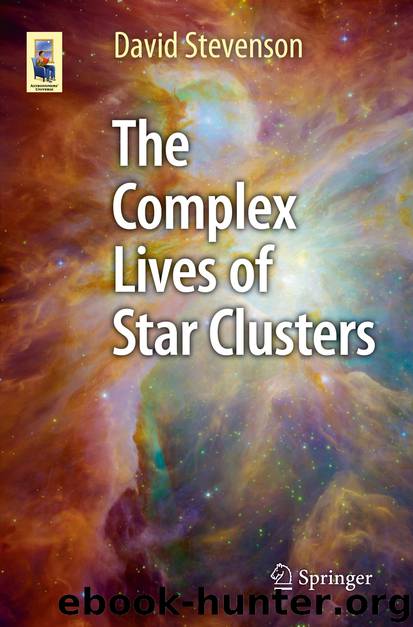The Complex Lives of Star Clusters by David Stevenson

Author:David Stevenson
Language: eng
Format: epub
Publisher: Springer International Publishing, Cham
W Ursa Majoris Stars
W Ursa Majoris (or W UMa) stars are contact binaries comprising two stars with masses comparable to the Sun, either somewhat more or somewhat less, and comparable in most cases to one another. As the name implies, a contact binary is one where the two stars are physically in contact with one another and share at least some of their outer envelope.
Initially, two types of W UMa systems were identified on the basis of their spectral type. In the A sub-class both stars are more massive than the Sun and have spectral classes A or F with orbital periods of 0.4–0.8 days. In these systems both stars have a broad area of contact between them with extensive exchange of matter between each. There is a relatively small difference in the mass of each star.
The W sub-class have components in spectral classes G or K. Since these are smaller stars, their orbital period must also be shorter if they are to be in contact. Thus these binaries have periods of 0.22–0.4 days. These stars are, generally, in less physical contact with one another and at least in some cases the W-class systems might evolve into the A-class, however, given that most W-systems are of lower mass than A-systems, this cannot be generally true.
In both A and W systems, both stars have surface temperatures that lie within a few hundred Kelvin of one another, at most. A third sub-class, B, was introduced in 1978. These contain two stars with a greater difference in mass and hence surface temperature. Further investigation by Szilard Csizmadia (Konkoly Observatory, Hungarian Academy of Sciences) and Péter Klagivik (Eötvös Loránd University) revealed a fourth sub-class, H, with even greater differences in the mass of stars in these systems. One star may be several times more massive than its partner which leads to some interesting exchanges in momentum between the two contacting stars as they rush past one another. The greater difference in the mass of the two components also restricts the effectiveness of the transport of energy between the two stars and thus explains the greater difference in their surface temperatures.
In most cases the two stars are both on the main sequence. However some W UMa systems have one component that has just left the main sequence and is expanding into a sub-giant star, en route towards the red giant branch.
As the two stars are physically in contact, the two stars take a lot less than a day to orbit one another. Their orbital periods may be apparent from periodic changes in the detectable light from the star if the eclipses are aligned with the Earth. The light will dip each time the two stars are pointing towards (or away from) the Earth. That the stars share their outer envelope allows each to share energy as well. The more massive component of the binary is somewhat under-luminous while the less massive star is far more luminous than it should be as a result of this energy transfer.
Download
This site does not store any files on its server. We only index and link to content provided by other sites. Please contact the content providers to delete copyright contents if any and email us, we'll remove relevant links or contents immediately.
| Aeronautics & Astronautics | Astronomy |
| Astrophysics & Space Science | Comets, Meteors & Asteroids |
| Cosmology | Mars |
| Solar System | Star-Gazing |
| Telescopes | UFOs |
Tools of Titans by Timothy Ferriss(8186)
Turbulence by E. J. Noyes(7920)
Secrets of Antigravity Propulsion: Tesla, UFOs, and Classified Aerospace Technology by Ph.D. Paul A. Laviolette(5299)
Astrophysics for People in a Hurry by Neil DeGrasse Tyson(5120)
Room 212 by Kate Stewart(5014)
Design of Trajectory Optimization Approach for Space Maneuver Vehicle Skip Entry Problems by Runqi Chai & Al Savvaris & Antonios Tsourdos & Senchun Chai(4996)
Pale Blue Dot by Carl Sagan(4886)
The David Icke Guide to the Global Conspiracy (and how to end it) by David Icke(4606)
A Journey Through Divination and Astronomy by Publishing Pottermore(4332)
Goodbye Paradise(3710)
Apollo 8 by Jeffrey Kluger(3620)
COSMOS by Carl Sagan(3539)
Losing the Nobel Prize by Brian Keating(3489)
The Five People You Meet in Heaven by Mitch Albom(3458)
How to Read Water: Clues and Patterns from Puddles to the Sea (Natural Navigation) by Tristan Gooley(3386)
Brief Answers to the Big Questions by Stephen Hawking(3356)
How to Read Nature by Tristan Gooley(3231)
The Order of Time by Carlo Rovelli(3131)
A Brief History of Time by Stephen Hawking(2946)
